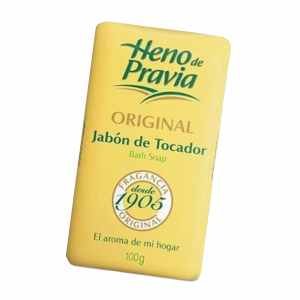Jabon Tocador Heno de Pravia ORIGINAL
4.7

Ingredientes
Sodium Tallowate
Ingrediente generalmente considerado seguro para su uso en productos de Belleza y Cuidado Personal.
Sodium Cocoate
Ingrediente potencialmente irritante y sensibilizador de la piel.
Aqua
Ingrediente generalmente considerado seguro para su uso en productos de Belleza y Cuidado Personal.
Parfum
El contacto directo con ciertas fragancias o aromas sintétocos inespecíficos puede ocasionar alergias, irritar o sensibilizar la piel.
Glycerin
Ingrediente generalmente considerado seguro para su uso en productos de Belleza y Cuidado Personal.
Phosphoric Acid
Existen restricciones en cuanto a la concentración máxima permitida y el tipo de formulaciones en los que puede utilizarse este ingrediente.
Sodium Chloride
Ingrediente generalmente considerado seguro para su uso en productos de Belleza y Cuidado Personal, en las condiciones actuales de concentración y prácticas de uso.
Sodium Hydroxide
Ingrediente generalmente considerado seguro para su uso en productos de Belleza y Cuidado Personal, en las condiciones actuales de concentración y prácticas de uso.
Cinnamyl alcohol
Ingrediente potencialmente irritante para la piel.
Citronellol
Ingrediente potencialmente irritante para la piel.
Coumarin
Ingrediente potencialmente irritante para la piel y alergénico.
Eugenol
Ingrediente potencialmente alergénico y sensibilizador de la piel.
Geraniol
Ingrediente potencialmente irritante para la piel.
Linalool
Ingrediente presente en la muchos de los aceites esenciales usados en productos de Belleza y Cuidado Personal, natural. En su forma pura sus efectos alérgenos son muy bajos. Sin embargo, en contacto con el aire, el Linalool puede oxidarse, dando lugar a la formación de productos con características alergénicas e irritantes para la piel.
Etidronic Acid
Ingrediente potencialmente irritante y sensibilizador de la piel.
Tetrasodium EDTA
Ingrediente generalmente considerado seguro para su uso en productos de Belleza y Cuidado Personal, en las condiciones actuales de concentración y prácticas de uso. Sin embargo, la sobreexposición a este ingrediente puede resultar tóxica.
Tetrasodium Etidronate
-
CI 11680 (Pigment yellow 1)
Ingrediente potencialmente sensibilizador de la piel.
CI 12490 (pigment red 5)
According to the classification provided by companies to ECHA in REACH registrations this substance may cause an allergic skin reaction. At least one company has indicated that the substance classification is affected by impurities or additives.
CI 74260 (Pigment green 7)
Ingrediente potencialmente sensibilizador de la piel.
CI 77891 (Titanium Dioxide)
Existen restricciones en cuanto a la concentración máxima permitida y el tipo de formulaciones en los que puede utilizarse este ingrediente. Potencialmente irritante y sensibilizador de la piel.
Más información
El análisis de ingredientes ha sido elaborado por investigadores del CONICET (*) en base a las siguientes referencias bibliográficas:
- European Chemicals Agency (ECHA) 2020. GHS Data from ECHA Website. Appears as: chemical_names: SODIUM COCOATE
- cas_numbers: 61789-31-9
- SCCNFP (The Scientific Committee on Cosmetic Products and Non-Food Products Intended for Consumers) 1999. Opinion concerning fragrance allergy in consumers. A review of the problem. Analysis of the need for appropriate consumer information and identification of consumer allergens. SCCNFP/0017/98 Final. December 199 - Tatyana Hamilton and Gillian C de Gannes. 2011. Allergic contact dermatitis to preservatives and fragrances in cosmetics. Skin therapy letter 16(4), 1-4 .- Anne Birgitte Simonsen, Mette Deleuran, Jeanne Duus Johansen and Mette Sommerlund 2011. Contact allergy and allergic contact dermatitis in children - a review of current data. Contact dermatitis 65(5), 254-65.
- Material Safety Data Sheet MSDS# 96129
- US - FOOD & DRUG Administration (FDA). Generally Recognized as Safe (GRAS) Substances (SCOGS) Database (SCOGS Number 32,1975. Conclusion 1)
- European Commission Legislation (Regulation (EC) N° 1223/2009 y 2019/831, Annexes I to VI and all the amendments to the cosmetics regulation).
- US - FOOD & DRUG Administration (FDA). Generally Recognized as Safe (GRAS) Substances (SCOGS) Database (SCOGS Number 102,1979. Conclusion 1 (dry food packaging), 4 (direct additive)
- US - FOOD & DRUG Administration (FDA). Generally Recognized as Safe (GRAS) Substances (SCOGS) Database (SCOGS Number 85,1976. Conclusion 1)
- SCCPNFP, 1999 Opinion Concerning Fragrance Allergy In Consumers, Scientific Committee On Cosmetic Products And Non-Food Products. SCCNFP/0017/98 Final, December 1999.
- Bråred Christensson J, Andersen KE, Bruze M, et al. Contact Dermatitis. 2012,67(5):247-259.
- European Chemical Agency (ECHA)
- Lanigan RS, Yamarik TA. Final report on the safety assessment of EDTA, calcium disodium EDTA, diammonium EDTA, dipotassium EDTA, disodium EDTA, TEA-EDTA, tetrasodium EDTA, tripotassium EDTA, trisodium EDTA, HEDTA, and trisodium HEDTA. Int J Toxicol. 2002
- 21 Suppl 2:95-142.
- American Society of Health-System Pharmacists 2013
- Drug Information 2013. Bethesda, MD. 2013
- SCCNFP/0005/98 (Scientific Committee on Cosmetic Products and Non-Food Products) Titanium Dioxide, adopted by the SCCNFP (2000). More information available online: http://ec.europa.eu/health/scientific_committees/consumer_safety/docs/sccs_o_136.pdf
- International Standards Organization (1995). Air Quality Particle Size Fraction Definitions for Health-related Sampling. (ISO Standard 7708), Geneva.
- Health and Safety Executive (2000). General Methods for Sampling and Gravimetric Analysis of Respirable and Inhalable Dust: Methods for the Determination of Hazardous Substances: MDHS 14/3. London.
- IARC: International Agency for Research on Cancer. IARC Monographs Volume 93. Titanium Dioxide. Pg. 199. Available online: https://monographs.iarc.fr/ENG/Monographs/vol93/mono93-7.pdf
- Moran CA et al. Hum Pathol 22 (5): 450-4 (1991)
- Pimentel JC. Acta Med Port 5 (6): 307-13 (1992)
- Rode LE et al. Acta Pathol Microbiol Scand A 89 (6): 455-61 (1981)
- Yamadori I et al. Acta Pathol Jpn 36 (5): 783-90 (1986)
- Fryzek JP et al. J Occup Environ Med 45 (4): 400-9 (2003)
- Churg A et al. Am J Physiol 277 (5 Pt 1): L975-82 (1999)
- Donaldson K et al. Inst Occupat Med Edinburgh Report No TM/88/01 (1988)
- https://www.cdhfinechemical.com/images/product/msds/110_1478813374_TitaniumDioxide-CASNO-13463-67-7-MSDS.pdf
- Aruoja V et al. Sci Total Environ 407 (4): 1461-1468 (2009)
- Heinlaan M et al. Chemosphere 71 (7): 1308-1316 (2008)
- Wiench K et al. Chemosphere 76 (10): 1356-65 (2009)
- Griffitt RJ et al. Environ Toxicol Chem 27 (9): 1972-78 (2008)
(*) Según el ranking SCImago 2020, el CONICET alcanza la segunda posición entre las instituciones académicas y de investigación más prestigiosas de América Latina. A nivel mundial, ocupa la posición 230 entre 7000 instituciones privadas y gubernamentales.

